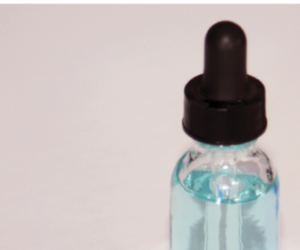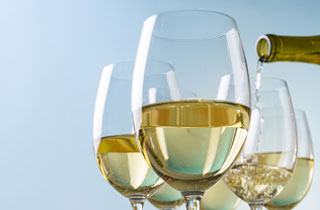There is a lot more to off-dry wines than what you may perceive from mass-produced discount bottles from the supermarket. A little sweetness with balanced acidity can add complexity and create a whole new tasting adventure. These aren’t the easiest wines to make, but they are rewarding on a summer day.
Winemaker: August Deimel, Keuka Spring Vineyards, Penn Yan, New York
Wines that will be finished sweeter ideally have a slightly different flavor profile than wines that will be bottled dry. We’re looking for slightly riper flavors. For example, in Riesling we’d like to see apricot and tropical notes rather than green apple or lemon/lime. To do that, we definitely need grapes that are a bit riper. We’re also a bit more tolerant of Botrytis. Having slightly higher sugars allows us to arrest fermentation early to preserve the grape’s natural sugar while still producing enough alcohol to make a sound and balanced wine. Now, there’s a caveat to this: If the grapes are on the vine too long (or especially in a hot year or hot region) the acid will drop out of the grapes and they’ll make for flabby off-dry wines.
Some grape varieties lend themselves to off-dry styles, others less so. Riesling and Chenin Blanc have both traditionally been used for this style because of their high acidity. Having enough acid to balance the sugar and avoid the trap of the wines becoming syrupy and cloying is absolutely key. Even though plenty of mass-market Chardonnay has a meaningful amount of residual sugar, that doesn’t mean it’s a good idea. I’ve found that Chardonnay often has too little acid to make a balanced wine at any sugar level other than dryness.
We have a pretty good sense of where we’re looking for our residual sugars to end up. We have an off-dry Gewürztraminer that clocks in around 7–10 grams/liter, a Riesling at 14–17 grams/liter, and a semi-sweet Riesling that sits between 30–45 grams/liter. We use the year as our guide as to whether we’re targeting the lower or the upper end of those ranges. In a cooler, wetter year we’re likely to target slightly higher residual sugars to balance out the anticipated higher acids. In a warmer year, we’ll go for the low end. Ultimately, we might produce 7–10 different lots of Riesling to blend together 3 different products. Each of those lots will have the fermentation stopped at a different residual sugar level. By judicious blending we can hit any residual sugar we want. Unfortunately, home winemakers will likely not have quite as many lots to play with, so blending is less of an option. Then you’ll need to stop the fermentation at just the right time, which is difficult without excellent temperature control (though sticking a carboy outside in a cold climate during winter and adding SO2 can do wonders).
A real problem with making off-dry whites at home is refermentation. Any bottled wine with residual sugar that has not been sterile filtered (through a 0.45 micron absolute filter) and bottled aseptically is at risk for exploding. If you don’t have this equipment, you could use high levels of SO2 and a good dose of potassium sorbate. This should result in a stable wine, but unfortunately you’ll be able to taste these additives, which may not be what you would want. Another option would be keeping the wine cold from bottling through to consumption. With reasonable levels of SO2, 45 °F (7 °C) or lower should most likely do the trick.
Winemaker: Megan McGrath Gates, Lucas & Lewellen Vineyards, Santa Barbara, California
Typically, our off-dry wines are made from white, aromatic grape varieties. We want our white wines to have low to moderate alcohols so we will pick at a level that equates with 12.5 to 13.5% alcohol, using a conversation rate of 0.6% of starting Brix to derive our projected % alcohol. It’s important to allow the grapes to ripen without accumulating too much sugar. This fine balance is mostly dependent on climate and canopy management. We pick the grapes when they reach ideal ripeness with many juice and grape parameters considered: Seed color and texture, stem color and texture, skin color and texture, taste, and chemistry.
The residual sugar range we use is 0.3% to 0.9%. My favorite off-dry wines are Viognier, Chenin Blanc, Malvasia Bianca, Muscat Canelli, and Gewürztraminer.
When planning to make an off-dry wine, in terms of pH and acidity, the wine can have a slightly lower pH and higher total acidity. This is because the sweetness is balanced out by the tartness. A high pH wine with residual sugar could end up tasting flabby. In terms of Brix, if the residual sugar is going to be substantially high, like in a late harvest wine of 7% residual sugar, then alcohol is important because there will be less sugar converted into ethanol (and CO2). Residual sugar can help offset higher alcohols by softening any bitterness or harshness due to the alcohol content.
Winemaker: Neil Collins, Tablas Creek, Paso Robles, California
When making these styles, the target residual sugar is decided ahead of time. We arrest the fermentation in order to retain natural sweetness from the grape juice in the resulting wine. We use yeast selection, monitoring, and temperature control to achieve a targeted residual sugar in our wine. When the sugar target is met, it’s important for tests to be conducted. We can’t rely on just our densitometer or hydrometer results. We take it to the next step and test it enzymatically or with a spectrophotometer. Once we are confident in the taste and lab results, we chill the wine to 32 °F (0 °C) and add potassium metabisulfite. We’ve had good results with ErboFerm™ InterDry, a yeast that is made for fermenting sweeter wines.
The most common problem in making this style is having a fermentation race through to dryness before you can measure it and arrest fermentation. That is why temperature control, and the special yeast, are so useful in terms of slowing things down so you have time to monitor the must. When a white fermentation is fermented above 55 °F (13 °C) it can finish fermentation very rapidly. We ferment our off-dry wines at about 50 °F (10 °C).
In the vineyard, the grapes used to make our naturally sweet Petit Manseng wines are treated no differently than any others; all organically farmed in the same way. We planted and use Petit Manseng for the purpose of making this sweeter style as that is tradition. This is surely because it produces high sugars while maintaining bracing acidity, lending itself perfectly to this style of wine to balance the sweetness.
We harvested our 2015 Petit Manseng at 28 °Brix and a pH of 3.28. We fermented it in barrel, and stopped its fermentation when it had about 82.4 grams/liter of sugar left and sat at an alcohol of 13.3%. The high acidity makes it taste much drier than the sugar reading would suggest.
We have taken a few vintages to settle on our residual sugar level, a decision made entirely on our tasting. We currently maintain a glucose fructose in the mid fifties. Balancing of sugar and acid is, of course, very important.
Some folks like to arrest the fermentation with a heavy sulfur addition, however we prefer to go direct to filtration, this minimizes the use of sulfur. I think that the biggest problem some winemakers have with off-dry wines is stopping of the fermentation. Getting to bottle sterile is a must.
In home winemaking, I would suggest maintaining a cool fermentation around 58 °F (14 °C) so fermentation is slower and easier to arrest.







